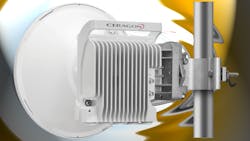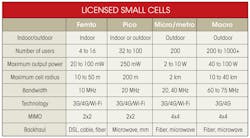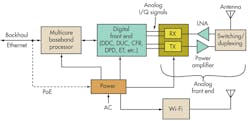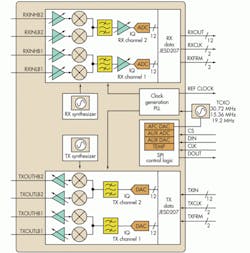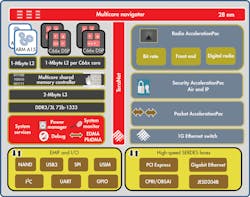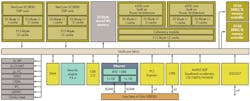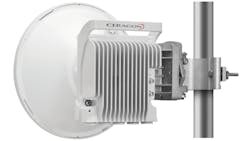Understanding The Small-Cell And HetNet Movement
This file type includes high resolution graphics and schematics when applicable.
Small cells are miniature cellular basestations with limited power and range. They complement larger macro basestations, which are the most common cell sites, to permit greater subscriber capacity and faster data speeds. Small cells are a growing trend that will have their greatest impact in 2014 and beyond.
Table of Contents
- Background
- Small Cells Defined
- Inside The Small Cell
- Timing And Synchronization
- Wi-Fi Offload
- Backhaul
- Self-Organizing Networks
- Distributed Antenna Systems
- Summary
- References
Background
A huge network of cell sites called macro basestations handles cell-phone traffic. With their high power, tall towers with multiple antenna arrays, long range, and backup power sources, macro basestations cover most of the U.S. except for some very rural and geographically challenged areas. There are nearly 300,000 such basestations in the U.S. Finding and securing suitable locations for basestations is getting increasingly difficult, though. The solution is the small cell.
In addition, the success of the smart phone and the growing subscriber demand for more and faster service are pushing cellular carriers to expand and upgrade their basestation deployments. The carriers responded by upgrading their systems with 4G Long Term Evolution (LTE), which offers significantly faster download speeds demanded by the major increase in video consumption. LTE is still being installed with full coverage not expected for several more years. One clear solution is the LTE small cell.
While the adoption of LTE will boost capacity and speed, limits are being reached. The orthogonal frequency-division multiplexing (OFDM) of LTE along with advanced modulation methods and multiple-input multiple-output (MIMO) have pushed the spectral efficiency (bits/Hz/Hz) of the cellular system to the Shannon limit. LTE-Advanced will improve speeds by providing more bandwidth through carrier aggregation. The ultimate limit is the spectrum available to the carrier. Again, small cells can provide an interim solution until more spectrum is freed up.
Another major issue for cell phones is indoor performance. More than 80% of all cell-phone calls occur in homes, offices, shopping malls, hotels, and other indoor venues. Indoor performance is significantly poorer than outdoor performance since the radio signals are seriously attenuated, distorted, and redirected by walls, ceilings, floors, furniture, and other obstacles. Indoor situations limit the range of the radio and greatly curtail data speeds. LTE is helpful in overcoming this problem, but the real solution is the small cell.
As it turns out, public and private Wi-Fi hotspots and access points fit the basic definition of a small cell. They can connect to a user smart phone, tablet, or laptop and provide access to video and other information and media demanded by the user. You don’t have to use the cellular network to download video or access other big data applications if a Wi-Fi hotspot is nearby. Most cellular small cells will include a Wi-Fi access point.
Groups of physically small cells can be installed anywhere, indoors or out. They can sit on a desk or be mounted on a wall, roof, lamppost, or light pole. The small cells fill in the gaps in coverage and provide service where macrocell coverage is poor.
There will be from five to 25 small cells per macro cell in most networks. Networks of small cells overlay, or as some say underlay, the macro network to provide an overall boost not only in data speeds but also subscriber capacity. The general customer performance is greatly improved with more reliable connections and significantly higher download speeds.
Distributed antenna systems (DASs) also are part of the small-cell trend. They use fiber-optic cable from a macro basestation to an array of antennas spread over a wide area to extend the reach and improve connection reliability. DASs are used in large buildings, airports, convention centers, and other large public venues. They could potentially be used to extend the range of small cells as well. Collections of macro basestations, small cells, Wi-Fi hotspots, and DASs are known as heterogeneous networks, or HetNets.
All small cells use the existing licensed spectrum assigned to the carrier’s networks. The limited spectrum is shared by frequency reuse and spatial diversity. Frequency reuse refers to the use of the same band by multiple cell sites. Spatial diversity means that these sites are spaced from one another so coverage areas do not overlap and power levels are controlled to eliminate or minimize interference with adjacent cells and with those on the same frequency.
Small Cells Defined
There are several different sizes and versions of small cells. They vary in the number of users they can handle, their power, and their range. In virtually all cases, they include the essential 3G technologies of the carrier, LTE and Wi-Fi. They also have a power source and a backhaul connection to the cellular network (see the table).
The smallest is the femtocell, which is a single-box basestation used by the consumer to improve local cellular service. Femtos have been around for years, and millions have been installed by most of the larger carriers. Backhaul is by way of the customer’s high-speed Internet connection via a cable TV or DSL telecom provider. There are also enterprise femtos that handle more users and provide a significant boost in indoor accessibility.
There are progressively larger small cells such as the picocell, microcell, and metrocell, each with increasing capacity, power, and range. Virtually all handle legacy 3G, LTE, and Wi-Fi. Many future small cells will also feature LTE-Advanced.
Inside The Small Cell
A small cell is still a cellular basestation but boiled down to only a few key chips and circuits. Thanks to super-fast multicore processors, a single IC easily can handle most 3G and LTE baseband operations. This baseband IC is then connected to the RF circuitry, making up the radio transceiver (Fig. 1).
The RF transceiver called the analog front end consists of the receiver (RX) and transmitter (TX). The receiver gets its signal from the antenna and amplifies it in a low-noise amplifier (LNA) and sends the signal to I/Q mixers forming a demodulator that recovers the signal. The signals are passed to analog-to-digital converters (ADCs) that create the input to the digital front-end processor.
Between the RF front end and the baseband processor is additional circuitry that performs decimation, digital upconversion (DUC), and digital downconversion (DDC). Other digital processing includes crest factor reduction (CFR), digital predistortion (DPD), and envelope tracking (ET). DPD and ET are used for linearization of the RF power amplifiers to improve efficiency. All this circuitry may be in a separate ASIC or FPGA, or it may be included in the baseband chip or front-end RF circuitry.
The baseband processor creates the digital I/Q signals for the transmitter. These signals go to digital-to-analog converters (DACs) in the analog front end that produce the equivalent analog signals. These signals then are sent to I/Q mixers that form a modulator. The modulator output is sent to one or more power amplifiers and then to the antenna.
The baseband processor has multiple-standard CPUs and DSPs. It also handles all the modulation, demodulation, and other processes involved with the various cellular standards. The I/O to the backhaul is typically by Ethernet. Power comes from a Power over Ethernet (PoE) connection if available or by some other source.
Maxim Integrated’s MAX2580 single-chip analog front end includes the I/Q modulator and demodulator as well as their fractional-N frequency synthesizers for channel selection (Fig. 2). The multiple circuits support 2x2 MIMO. The synthesizers cover all LTE bands 1 to 41 and provide for bandwidth selection from 1.4 MHz to 20 MHz. The ADCs and DACs are included on chip. The digital interfaces to the baseband processor are JESD207.
The receiver section includes the LNAs, though additional external LNAs could be added if necessary. The transmitter output amplifiers provide 0 dBm. If more power is needed, external power amplifiers can be added. Maxim makes a wide range of other RF circuits including the MAX2550-MAX2553 3G femtocell transceivers for CDMA systems.
Texas Instruments’ similar AFE7500 RF front-end chip has two separate transmit and receive streams to support 2x2 MIMO. It also includes all of the ADCs and DACs. A separate single-path receiver accommodates the feedback from the antenna needed by the DPD linearization circuits. The interface to the baseband processor is the JESD204B.
TI also has a full line of mulitcore processors to support the basestation needs. The KeyStone line includes a mix of ARM A15 RISC processors as well as TI’s well-known C66x DSPs. The TCI6630K2L features two ARM cores and four C66x DSPs (Fig. 3). It also has multiple accelerators to speed up operations, minimize the number of cores, and reduce power consumption. Further, it includes the digital front-end circuits like DUC/DDC/DPD/CFR. Multiple interfaces include JESD240B, PCI Express, SPI, USB, and a Gigabit Ethernet switch.
Freescale makes a full line of wireless infrastructure processors, including the QorIQ Qonverge BSC9131 for home and small business femto cells for up to 16 users, the BSC9132 for enterprise femtocells or picocells with up to 100 users, the B4420 for larger metrocell and microcells, and the B4860 for macrocells. All support LTE-FDD, TD-LTE, and LTE-Advanced as well as WCDMA and HSPA 3G standards. The BSC9132 comprises two Power Architecture e500 RISC cores and two StarCore SC3850 DSPs plus the MAPLE B2P baseband accelerators (Fig. 4). Multiple I/Os permit connection to a variety of RF chips including the MAX2580.
Finally, most small cells will include Wi-Fi and possibly GPS. Power will come from PoE plus a mix of dc-dc converters and regulators. The RF power amplifiers and the baseband processor system-on-chip (SoC) consume most of the power.
Timing And Synchronization
A key requirement of all LTE basestations, macro or small-cell, is timing and synchronization of all the radios in the network. Timing and synchronization are essential to meet the specifications of the Third Generation Partnership Project (3GPP), the organization establishing the LTE standards. Timing and synchronization are implemented by delivering a formatted clock signal to the radio circuits of the basestation. These signals are then used to create the phase and frequency components of the LTE modulation. Timing and synchronization are also essential for proper handoff and backhaul coordination.
Several timing and synchronization methods have been developed including synchronous Ethernet (SyncE) or G.8262 by the ITU and the IEEE’s Precision Time Protocol (PTP) 1588-2008. Both are used, but PTP 1588-2008 seems to be preferred. PTP can be delivered with a grandmaster clock in the form of a timestamp over the packet network. An alternative, Network Time Protocol (NTP), is designed to synchronize clock to some time reference over a variable latency data network.
The timing requirements for implementing LTE in the network are severe. The typical clock precision required is 16 parts per billion (ppb) in the transport network and 50 ppb in the air interface. For TDD and Advanced versions of LTE, the phase requirements are also critical. In addition, the method of backhaul will vary with different types of small cells. Many will use microwave. Others will use fiber. In residential femtos, DSL or cable TV provide the backhaul. Different timing schemes are needed to optimize the performance.
The LTE-Advanced small cells to come will have strict timing and synchronization requirements to implement the key features of enhanced inter-cell interference coordination (eICIC) and coordinated multipoint transmission/reception (CoMP). These interference management technologies are required for self-organizing networks (SON).
Wi-Fi Offload
The concept of Wi-Fi offload is simple. It is the formal use of available hotspots and access points to carry the high-speed data, relieving the cellular network of that burden. Since all smart phones have Wi-Fi, it is possible to create a system that automatically selects Wi-Fi for a fast download if a hotspot is nearby. While subscribers could voluntarily access the data with Wi-Fi, they may not be aware of a useable hotspot.
By offloading the cellular system, that network can handle more users with high-speed data needs that cannot be addressed with Wi-Fi. Today, users can automatically offload the network themselves by actively seeking an available hotspot to avoid the cost of using the cellular network. Otherwise, an automatic carrier-driven approach can be implemented to make the offload work seamlessly when users access high-volume downloads.
While the ultimate solution is to roll out a small-cell underlay to increase capacity and coverage, Wi-Fi offers an immediate solution to the demand for faster downloads. Since high-speed traffic like video is growing faster than the carriers can implement a full small-cell system, Wi-Fi offers a fast and inexpensive way to deal with the problem. To make this work, several things must happen.
First, cellular operators will have to partner with existing Wi-Fi providers in their coverage areas. Alternately, the cellular operators will need to build out their own Wi-Fi networks. Many have already constructed their own Wi-Fi networks to ensure the desired coverage. Wi-Fi networks are significantly less expensive to install than cellular basestations, including small cells. And, they are usually faster than most 4G networks. These cellular operator Wi-Fi networks are called carrier-grade networks.
Second, some mechanism is needed to initiate an automatic selection of Wi-Fi versus cellular networks when a subscriber attempts to access some source of video or other big data. A subscriber’s smart phone or tablet will seek out the available networks and then select the best option, mostly favoring Wi-Fi if it is available. Up to 50% of cellular data traffic will eventually be offloaded to Wi-Fi, giving carriers time to roll out more small cells, expand their LTE networks, or add new spectrum while minimizing capital expenditures.
The mechanism for this is now available in the form of the Wi-Fi Alliance’s Hotspot 2.0 and the IEEE 802.11u standard. First, 802.11u is a relatively recent enhancement to the 802.11 wireless local-area network (WLAN) standards. It enables Wi-Fi to work with other networks including cellular networks. The enhancement essentially automates the connection between a smart phone, tablet, or laptop to different Wi-Fi networks. It replaces the process of discovering nearby hotspots, entering passwords, authenticating, and connecting.
Next, Hotspot 2.0 is an addition to the basic standard that uses 802.11u to automate access point discovery, registration, provisioning, and connection. This not only enables roaming between hotspots, it also provides a mechanism to link to cellular networks to perform automated handoff between the cellular network and available Wi-Fi hotspots.
Virtually all 3G/4G small cells will also include carrier-grade Wi-Fi either in the same enclosure or in an adjacent box. Furthermore, the newer cell-phone models will incorporate Hotspot 2.0/802.11u to make the offload option function. Cellular operators see the offload strategy as a way to buy time until more wireless spectrum is available or as funds are available to acquire it.
Backhaul
Backhaul is the name of the connection of a cell site to the core network. Most macro basestations in the U.S. use fiber-optic cable. Some carriers in hard-to-reach areas use a microwave link. Fiber is preferred, of course, as it is fast and reliable. But it is costly to install since it requires access to property, digging in the ground, or permission to use power poles. Microwave is simply line-of-sight (LOS) point-and-shoot wireless. It is not as fast, but that limitation is gradually going away with the new systems. With most microwave links, data capacity up to 1 Gbit/s is usually available.
Small-cell backhaul will most likely be a mix of fiber and wireless. If fiber is available and affordable, it will be used. Otherwise, a wireless link will be the backhaul of choice. Small-cell backhaul also will be tricky sometimes.
With small cells on lampposts, sides of buildings, and other odd locations, fiber or even ac power may be hard to come by. A wireless link may be the only choice, and even that could be a challenge in large cities with tall buildings and other structures blocking most paths back to the core network. Multiple-hop links may be used in some instances.
The most popular wireless backhaul frequencies are 6, 11, 18, and 23 GHz. These frequencies require a license to use, and equipment is generally expensive. However, other potential bands are the 60-GHz band and 70/80-GHz E-band. The 80-GHz band requires a license, but the 60-GHz band does not. The 60-GHz band (57-64 GHz) is an industrial-scientific-medical (ISM) band that is open to any service.
The millimeter-wave bands above 30 GHz offer lots of bandwidth to support higher data rates, but their range is severely limited by the physics of their short wavelength. With high-gain directional antennas and higher power, though, ranges can extend to several kilometers. Just recently the Federal Communications Commission modified the Part 15 rules and regulations to permit higher power and antenna gains in the 60-GHz band to make it more useful for small-cell backhaul (Fig. 5).
Self-Organizing Networks
Self-organizing networks (SONs) are a software solution to managing a HetNet. While the interaction between macrocells is usually managed manually, with multiple small cells, such a manual task is overwhelming. With SON, the HetNet will essentially manage itself. SON can automate configuration and dynamically optimize the network based on the traffic loads.
SONs can be categorized by their three basic functions: self-configuration, self-optimization, and self-healing. Self-configuration adjusts the small-cell frequency, power level, and interfaces automatically as the device joins the system. It works with the automatic neighbor relations (ANR) software that builds and maintains a list of all cells in the network and the location and physical characteristics of each (see “Test ANR Functionality On Your LTE Devices” at electronicdesign.com). If any new cell is added, the configuration is automatic and the list is updated. The same occurs if a cell is removed.
Self-optimization refers to the ability of the network to adapt itself to surrounding conditions and optimize its performance based on coverage, capacity, handover between cells, and interference. Two key functions are load balancing and interference mitigation. Load balancing is dividing the traffic between the cells so no one cell becomes too overloaded if adjacent cells are within range and have available capacity. Load balancing occurs automatically. This ability also helps balance the backhaul traffic load.
Interference management is essential in a HetNet since the small cells are generally closely spaced and could potentially interfere with one another. SON software uses the cells to measure the characteristics of nearby cells to determine if interference is a possibility. It then makes adjustments dynamically to change frequency or power level as necessary to minimize interference.
Self-healing refers to a SON’s ability to adjust to changing conditions such as cell failure. SON technology is a key part of HetNets, and the LTE standard supports it. Tests have shown that SON can monitor and update a network within milliseconds in some cases and dynamically adapt. Overall throughput can be improved by 10% to 45% in many cases.
This file type includes high resolution graphics and schematics when applicapable.
Distributed Antenna Systems
DASs also are a key part of the HetNet movement. A DAS isn’t exactly a small cell, but it similarly improves coverage and performance in a given region. A DAS expands the coverage on a given basestation by distributing the signal over a wider area using a network of antennas. It is useful for improving coverage in multi-floor office buildings, stadiums, hotels, malls, airports, and subways, as well as tunnels and roadways. It can be used indoors or outdoors, although indoor coverage is more common.
A DAS connects to an existing macro basestation either directly or by a wireless link. It then distributes this service over fiber-optic cable or coax cable or some combination. Typically the unit connected to the basestation involves a repeater that amplifies the signal and sends it to various regions in the coverage area by way of a fiber-optic cable. In some cases no amplification is used. The RF signals are simply transported over the fiber.
The fiber connects to distribution boxes that convert the signals for coax cable distribution to an array of antennas. These antennas must be separated from one another by several wavelengths to be effective. The array divides the transmitted power among the antennas. While the signal at each antenna is smaller, it typically is a better signal than what might be an even smaller signal directly from the basestation. A DAS eliminates dead zones caused by the huge attenuation with distance and through walls, ceilings, and other obstructions. It provides a more direct line-of-sight connection to the cell phone or other user device.
A DAS may be passive or active. Passive systems are simplest and use a mix of filters, splitters, and couplers to distribute the signals. Active systems use amplifiers and repeaters to boost signal levels. The facility owner usually owns the DAS instead of the cellular carrier, like other small cells. A distribution agreement with the carrier is necessary. DAS may be carrier-specific or generic to handle any 2G/3G/4G signals. Some DASs work with Wi-Fi as well.
Summary
Only a few small cell networks are around now, but many are expected in the future. The major carriers will undergo many trials and tests as they attempt to solve the many challenges of placing and provisioning small cells. The larger rollout of small cells will begin in 2014 and continue thereafter. Small cells not only will improve smart-phone and tablet operations but also will accelerate mobile cloud applications and machine-to-machine (M2M) services. Then 5G systems will emerge, including a small-cell solution.
References
Bleicher, Ariel, “A Surge in Small Cells,” IEEE Spectrum, January 2013.
Andrews, Jeffery, “Seven Ways that HetNets Are a Cellular Paradigm Shift,” IEEE Communications Magazine, March 2013
HetNet Forum, formerly the DAS Forum, www.thedasforum.org
Hwang, B.S., Soliman, S.S., “A Holistic View on Hyper-Dense Heterogeneous and Small Cell Networks,” IEEE Communications Magazine, June 2013.
Peng, M., et al., “Self-Configuration and Self-Optimization in LTE-Advanced Heterogeneous Networks,” IEEE Communications Magazine, May 2013.
Small Cell Forum, www.smallcellforum.org
About the Author

Lou Frenzel
Technical Contributing Editor
Lou Frenzel is a Contributing Technology Editor for Electronic Design Magazine where he writes articles and the blog Communique and other online material on the wireless, networking, and communications sectors. Lou interviews executives and engineers, attends conferences, and researches multiple areas. Lou has been writing in some capacity for ED since 2000.
Lou has 25+ years experience in the electronics industry as an engineer and manager. He has held VP level positions with Heathkit, McGraw Hill, and has 9 years of college teaching experience. Lou holds a bachelor’s degree from the University of Houston and a master’s degree from the University of Maryland. He is author of 28 books on computer and electronic subjects and lives in Bulverde, TX with his wife Joan. His website is www.loufrenzel.com.
